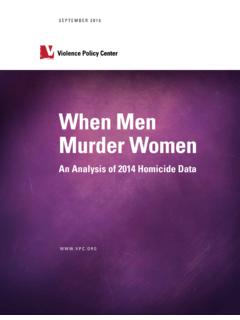Transcription of When Men Murder Women - Violence Policy Center
1 SEPTEMBER 2017. When Men Murder Women An Analysis of 2015 Homicide Data W W P C . O R G. WHEN MEN Murder Women Violence Policy Center | 1. COPYRIGHT AND ACKNOWLEDGMENTS. Copyright September 2017 Violence Policy Center The Violence Policy Center (VPC) is a national nonprofit educational organization that conducts research and public education on Violence in America and provides information and analysis to policymakers, journalists, advocates, and the general public. This study was funded with the support of The Herb Block Foundation and The Joyce Foundation. When Men Murder Women was also supported by generous gifts from Robert Woodcock and other Violence Policy Center supporters. For a complete list of VPC publications with document links, please visit To learn more about the Violence Policy Center , or to make a tax-deductible contribution to help support our work, please visit Violence Policy Center 1025 Connecticut Avenue, NW Suite 1210.
2 Washington, DC 20036. (202) 822-8200. 2 | Violence Policy Center WHEN MEN Murder Women . TABLE OF CONTENTS. Introduction 1. Section One: National Data 4. Section Two: Black Females 6. Section Three: Laws that Help Protect Women from Abusers 7. Conclusion 8. Appendix One: Number of Females Murdered by Males in Single Victim/Single Offender Homicides and Rates by State, 2015 9. Appendix Two: Additional Information for the 10 States with the Highest Rates of Females Murdered by Males 11. Alaska 11. Nevada 12. Louisiana 13. Tennessee 14. South Carolina 15. Arkansas 16. Kansas 17. Kentucky 18. Texas 19. New Mexico 20. Missouri 21. United States 22. Understanding the Statistics 23. This study is published in PDF format and is designed to be printed in color as a single-page document. WHEN MEN Murder Women Violence Policy Center . INTRODUCTION. Intimate partner Violence against Women is all too common and takes many The most serious is homicide by an intimate partner.
3 2 Guns can easily turn domestic Violence into domestic homicide. One federal study on homicide among intimate partners found that female intimate partners are more likely to be murdered with a firearm than all other means combined, concluding that the figures demonstrate the importance of reducing access to firearms in households affected by IPV [intimate partner Violence ]. 3. Guns are also often used in non-fatal domestic Violence . A study by Harvard School of Public Health researchers analyzed gun use at home and concluded that hostile gun displays against family members may be more common than gun use in self-defense, and that hostile gun displays are often acts of domestic Violence directed against Women . 4. The Department of Justice has found that Women are far more likely to be the victims of violent crimes committed by intimate partners than men, especially when a weapon is involved.
4 Moreover, Women are much more likely to be victimized at home than in any other A woman must consider the risks of having a gun in her home, whether she is in a domestic Violence situation or not. While two thirds of Women who own guns acquired them primarily for protection against crime, the results of a California analysis show that purchasing a handgun provides no protection against homicide among Women and is associated with an increase in their risk for intimate partner homicide. 6 A 2003 study about the risks of firearms in the home found that females living with a gun in the home were nearly three times more likely to be murdered than females with no gun in the Finally, another study reports, Women who were murdered were more likely, not less likely, to have purchased a handgun in the three years prior to their deaths, again invalidating the idea that a handgun has a protective effect against While this study does not focus solely on domestic Violence homicide or guns, it provides a stark reminder that domestic Violence and guns make a deadly combination.
5 According to reports submitted to the Federal Bureau of Investigation (FBI), firearms are rarely used to kill criminals or stop Instead, 1 See for example, Shannan Catalano, , et al., Female Victims of Violence , Bureau of Justice Statistics, September 2009. 2 An intimate partner or intimate acquaintance is defined as a spouse, common-law spouse, ex-spouse, or girlfriend/boyfriend. 3 Leonard J. Paulozzi et al., Surveillance for Homicide Among Intimate Partners United States, 1981-1998, Morbidity and Mortality Weekly Report (MMWR) Surveillance Summaries 50 (October 12, 2001): 1-16. 4 Deborah Azrael and David Hemenway, In the Safety of Your Own Home': Results from a National Survey on Gun Use at Home, Social Science &. Medicine 50 (2000): 285-291. 5 Diane Craven, Sex Differences in Violence Victimization, 1994, Bureau of Justice Statistics Special Report (Washington, DC: Government Printing Office, 1997).
6 6 Garen Wintemute et al., Increased Risk of Intimate Partner Homicide Among California Women Who Purchased Handguns, Annals of Emergency Medicine 41, no. 2 (2003): 282. 7 Douglas Wiebe, Homicide and Suicide Risks Associated with Firearms in the Home: A National Case-Control Study, Annals of Emergency Medicine 41, no. 6 (2003): 775. 8 Grassel et al., Association between Handgun Purchase and Mortality from Firearm Injury, Injury Prevention 9 (2003): 50. 9 In 2015, justifiable homicides involving Women killing men occurred in: Arizona (1); California (1); Georgia (1); Iowa (1); Illinois (1); Indiana (1); Kentucky (1); Michigan (2); Missouri (1); New Jersey (1); South Carolina (4); Tennessee (6); Texas (1); and, Wisconsin (1). In 2015, justifiable homicides involving Women killing men with a firearm occurred in: California (1); Georgia (1); Indiana (1); Kentucky (1); Michigan (1); Missouri (1); New Jersey (1); South 1 | Violence Policy Center WHEN MEN Murder Women .
7 They are all too often used to inflict harm on the very people they were intended to protect. According to the FBI's Uniform Crime Reports, in 2015 there were only 328 justifiable homicides committed by private citizens. Of these, only 23 involved Women killing men. Of those, only 16 involved firearms, with 14 of the 16 involving handguns. While firearms are at times used by private citizens to kill criminals, the Centers for Disease Control and Prevention reports that the most common scenarios of lethal gun use in America in 2015, the most recent final data available, are suicide (22,018), homicide (12,979), or fatal unintentional injury (489). When Men Murder Women is an annual report prepared by the Violence Policy Center detailing the reality of homicides committed against females by single male offenders. The study analyzes the most recent Supplementary Homicide Report (SHR) data submitted to the Federal Bureau of The information used for this report is for the year 2015.
8 Once again, this is the most recent data available. This is the first analysis of the 2015 data on female homicide victims to offer breakdowns of cases in the states with the 10 highest female victim/male offender homicide rates, and the first to rank the states by these rates. This study examines only those instances involving one female homicide victim and one male offender. This is the exact scenario the lone male attacker and the vulnerable woman that is often used to promote gun ownership among Women . This is the 20th edition of When Men Murder Women . From 1996 to 2015, the rate of Women murdered by men in single victim/single offender incidents dropped from per 100,000 Women in 1996 to per 100,000 Women in 2015, a decrease of 29 percent (see graph on the following page). The data presented over the years in When Men Murder Women coincides with the passage and implementation of the Violence Against Women Act (VAWA), which will be 23 years old this year, as well as the passage of restrictions on firearms possession by persons with misdemeanor convictions for domestic Violence or those who are subject to certain protective orders for domestic Violence .
9 Since the passage of these laws, domestic Violence has increasingly been treated as the serious problem that it is. States have also reformed their laws to better protect victims of domestic abuse and remove firearms from persons with histories of domestic Violence . Carolina (4); Tennessee (3); Texas (1); and, Wisconsin (1). Of these, handguns were used in: California (1); Georgia (1); Indiana (1); Kentucky (1);. Michigan (1); Missouri (1); South Carolina (4); Tennessee (2); Texas (1); and, Wisconsin (1). 10 The Federal Bureau of Investigation's Uniform Crime Reporting (UCR) Program collects basic information on serious crimes from participating police agencies and records supplementary information about the circumstances of homicides in its unpublished Supplementary Homicide Report (SHR). Submitted monthly, supplementary data consists of: the age, sex, race, and ethnicity of both victims and offenders; the types of weapons used; the relationship of victims to offenders; and, the circumstances of the murders.
10 According to the FBI's Uniform Crime Reporting Program, supplementary data are provided on only a subset of homicide cases. Additionally, SHR data are updated throughout the year as homicide reports are forwarded by state UCR programs. WHEN MEN Murder Women Violence Policy Center | 2. Rate of Women Murdered by Men in Single Victim/Single Offender Incidents 1996 - 2015.. 1996 1997 1998 1999 2000 2001 2002 2003 2004 2005 2006 2007 2008 2009 2010 2011 2012 2013 2014 2015. In 2015, there were 1,686 females murdered by males in single victim/single offender incidents that were submitted to the FBI for its Supplementary Homicide These key findings of this study, expanded upon in the following sections, dispel many of the myths regarding the nature of lethal Violence against females. n For homicides in which the victim to offender relationship could be identified, 93 percent of female victims (1,450 out of 1,551) were murdered by a male they knew.











